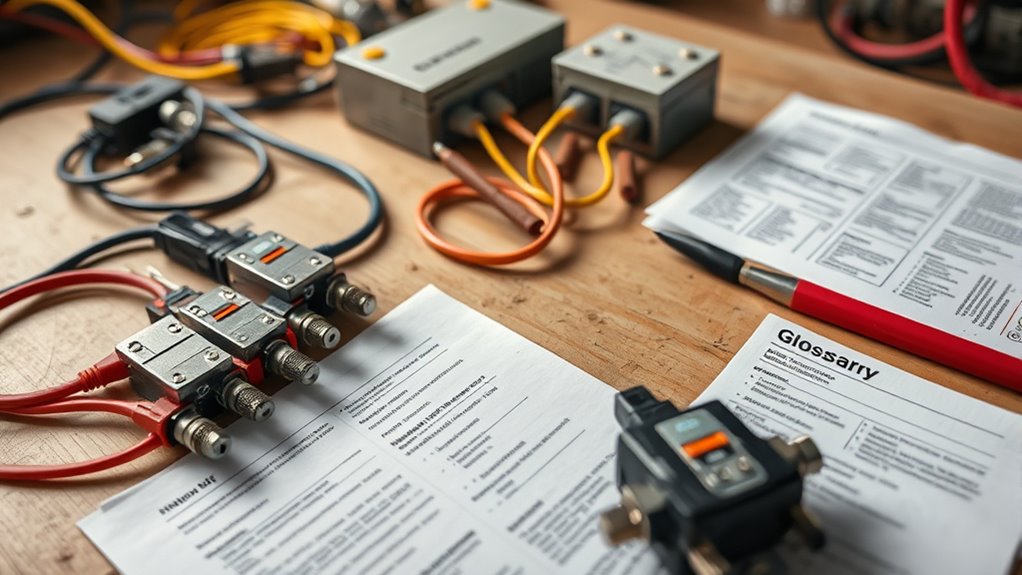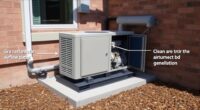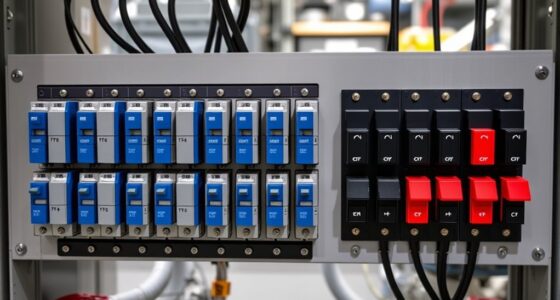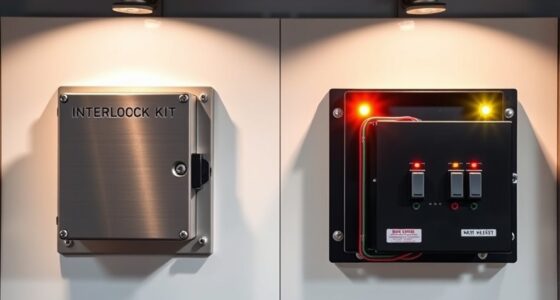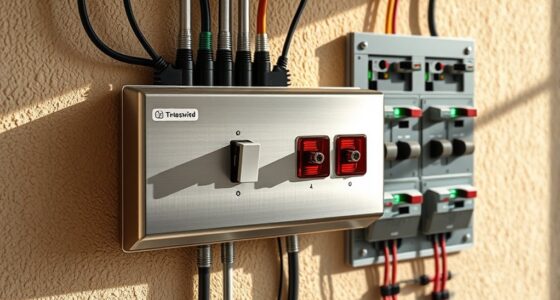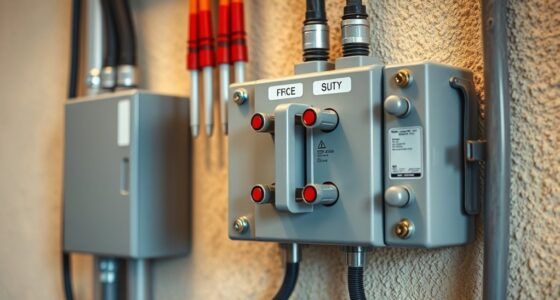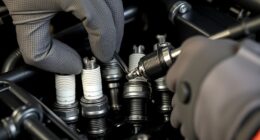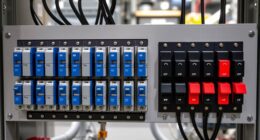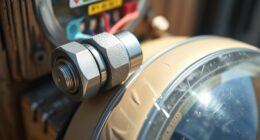Understanding the difference between interlock kits and transfer switches is key to choosing the right backup power solution. Interlock kits are simple, mechanical devices that prevent you from energizing your home circuits when utility power is on. Transfer switches automatically or manually switch your home’s power source during outages, offering more convenience and safety. To guarantee proper safety and compliance, it’s essential to know how each option works and fits your needs—more details wait ahead.
Key Takeaways
- Interlock kits are mechanical devices preventing concurrent utility and generator power, while transfer switches automate power switching during outages.
- Transfer switches offer seamless, automatic power transfer and better long-term durability compared to simpler interlock kits.
- Interlock kits are generally more affordable but require manual operation; transfer switches often involve higher installation costs but provide automation.
- Proper installation, maintenance, and adherence to electrical codes are essential for both systems’ safety and reliability.
- Choose based on budget, home compatibility, automation needs, and climate considerations for optimal backup power management.
What Is an Interlock Kit?
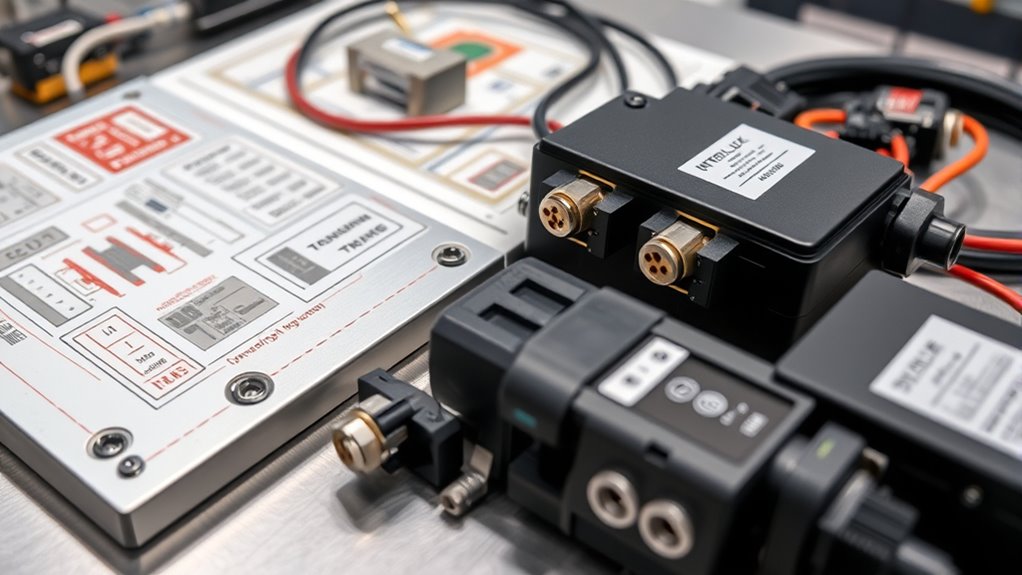
Have you ever wondered how to safely connect a generator to your home’s electrical system? An interlock kit is a device that allows you to do this without violating electrical code or risking backfeed. It’s a mechanical safety feature installed on your main breaker panel, preventing the generator from energizing your home’s circuits when utility power is on. To guarantee safe operation, regular generator maintenance is essential, including checking connections and testing the interlock. The interlock kit works by physically blocking the main breaker when the generator breaker is engaged, reducing the risk of electrical hazards. This simple yet effective tool helps you comply with electrical code requirements while providing a reliable backup power solution. Whole-house water systems can also benefit from proper installation and maintenance to ensure consistent water quality and flow.
Understanding Transfer Switches
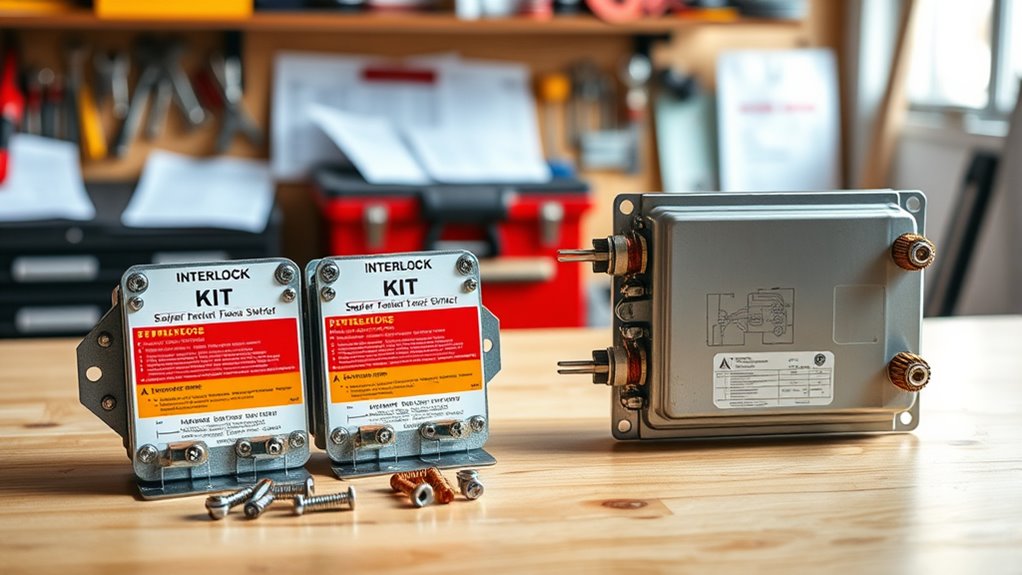
Wondering how to switch your power source seamlessly during an outage? Transfer switches make this process simple and safe. They guarantee generator compatibility by automatically or manually connecting your generator to your home’s electrical system. This device controls power distribution, preventing backfeed that could harm utility workers or damage your generator. When the grid fails, the transfer switch isolates your home from the utility line and switches to generator power instantly. This quick transition minimizes downtime and keeps your appliances running smoothly. Transfer switches can be manual or automatic, giving you flexibility based on your needs. By managing power sources safely, they protect both your equipment and your household while maintaining a reliable power flow during outages. Understanding transfer switch functions ensures proper operation and safety.
Key Differences Between Interlock Kits and Transfer Switches
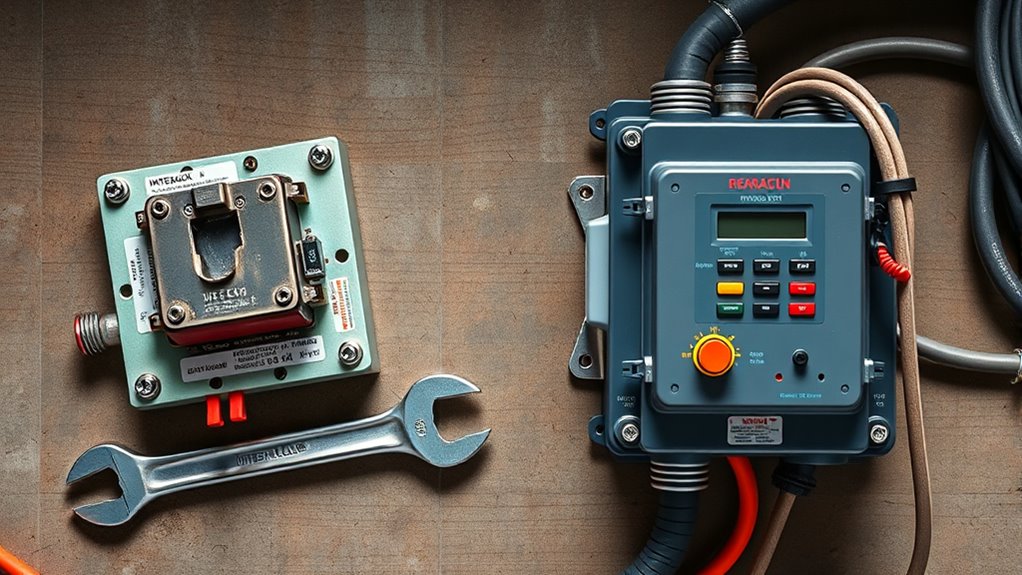
When choosing between interlock kits and transfer switches, you’ll notice they differ in installation complexity, cost, and your overall budget. Interlock kits are typically simpler and more affordable, making them easier to set up without professional help. Transfer switches, on the other hand, usually require a higher investment but offer more advanced functionality. Additionally, selecting a name for your dog can reflect its personality and help foster a stronger bond.
Installation Complexity Levels
Understanding the installation complexity of interlock kits versus transfer switches is crucial for ensuring a safe and efficient backup power setup. The installation process for interlock kits tends to be simpler, often involving basic electrical work that you can usually handle yourself with proper knowledge. They require minimal modifications to your main panel, making them less technically complex. Transfer switches, on the other hand, usually involve a more intricate setup, often requiring a dedicated circuit and professional installation due to the increased technical complexity. They may need wiring adjustments and adherence to local electrical codes, which can extend installation time and costs. Overall, interlock kits are less complicated to install, while transfer switches demand a higher level of technical expertise. Additionally, considering security vulnerabilities and compliance requirements can influence the choice of installation method for your backup power system.
Cost and Budget Differences
The cost difference between interlock kits and transfer switches can considerably impact your budget for backup power solutions. When doing a cost comparison, interlock kits are generally more affordable upfront, often saving you money on installation and materials. Transfer switches, however, tend to have higher initial costs but can offer long-term savings through increased durability and easier maintenance. Your budget planning should consider not just the initial expense but also ongoing costs like repairs and upgrades. If you’re working with a tight budget, interlock kits may be the better choice, especially for smaller setups. On the other hand, if you prioritize reliability and ease of use, investing in a transfer switch might be worth the extra expense. Additionally, understanding the cost and budget differences can help you make informed decisions tailored to your specific needs.
How Do Interlock Kits Work During Power Outages?
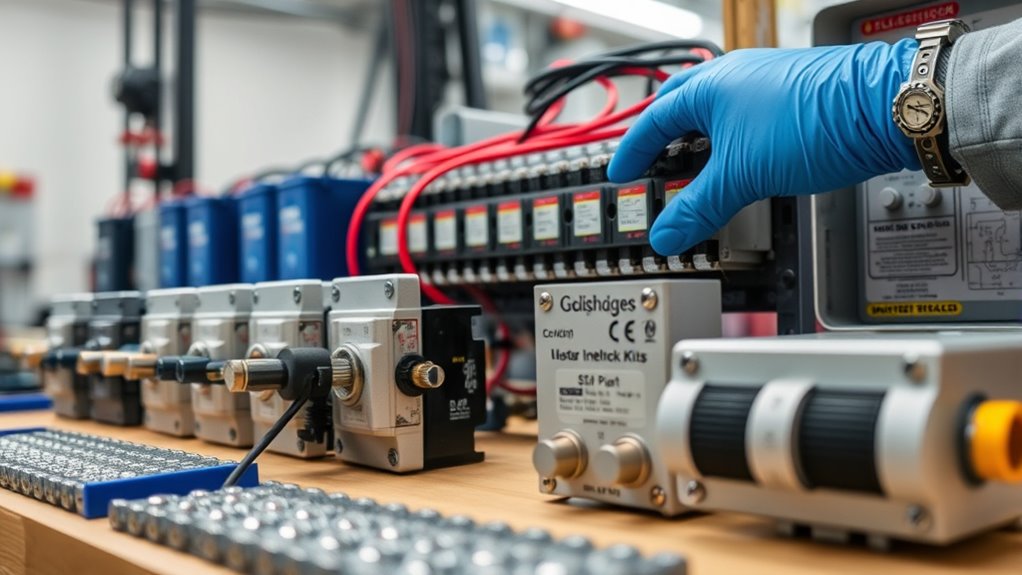
During a power outage, interlock kits prevent backfeeding risks by ensuring your generator can’t supply power to the grid. You manually activate the transfer switch to connect your generator to your home’s circuits safely. This process guarantees a safe, controlled power transfer, protecting both your equipment and utility workers. Additionally, incorporating security lighting can further deter potential intruders during outages.
Prevents Backfeeding Risks
When a power outage occurs, interlock kits work to prevent backfeeding by physically preventing the main breaker and generator breaker from being turned on simultaneously. This safeguard guarantees that electricity from your generator doesn’t flow back into the utility lines, protecting utility workers and your home. Proper generator sizing and power source compatibility are vital for effective operation. If your generator is too small or incompatible, it may not supply enough power or could cause backfeeding issues. Interlock kits are designed to work only when your equipment meets these standards. They also help avoid dangerous voltage surges and electrical fires. Additionally, understanding the difference between various safety measures, such as electrical safety, can further enhance your home’s protection during outages.
- Guarantees safe separation between utility and generator power
- Prevents accidental energizing of utility lines
- Protects both your home and utility personnel
Manual Transfer Activation
Ever wonder how you manually activate your transfer switch during a power outage? It’s straightforward but essential to follow proper safety protocols. First, you locate the transfer switch and ensure the main breaker is turned off to prevent backfeeding. Then, you manually activate the transfer switch by moving the handle or switch lever into the appropriate position, connecting your generator to the home’s electrical system. This manual activation allows power from your generator to safely feed selected circuits, avoiding hazards. Always double-check that the transfer switch is securely engaged and that all safety measures are in place before restoring power. Additionally, understanding electricity distribution and the role of transfer switches can help you better manage your power sources and ensure safety during outages. Remember, adhering to safety protocols during manual transfer activation keeps you protected and ensures a smooth, safe transition during outages.
Ensures Safe Power Switching
Interlock kits are designed to guarantee safe power switching by preventing the simultaneous connection of your home and generator to the main power line. This ensures generator safety and circuit protection during outages. When you switch to generator power, the interlock kit automatically blocks the main breaker, preventing backfeed that could harm utility workers or damage equipment. This simple, effective system keeps your household circuits protected from overloads and faults.
Key benefits include:
- Prevents dangerous backfeed to utility lines
- Ensures only one power source is active at a time
- Maintains circuit protection and generator safety
The Functionality of Transfer Switches in Emergency Power

How do transfer switches guarantee your power stays on during an outage? They automatically detect power loss and switch your load from the utility to your generator, assuring continuous supply. This process minimizes downtime and prevents overloads. Transfer switches also help optimize fuel efficiency by controlling generator operation, so it runs only when needed. Additionally, they reduce noise levels by managing generator start-up and shutdown smoothly.
| Feature | Benefit |
|---|---|
| Automatic switching | Ensures seamless power flow during outages |
| Fuel efficiency | Saves fuel by preventing unnecessary generator use |
| Noise levels | Reduces loud startup and operation noise |
| Load management | Balances power demand effectively |
| Safety | Isolates your system from grid during failure |
Safety Considerations and Code Compliance
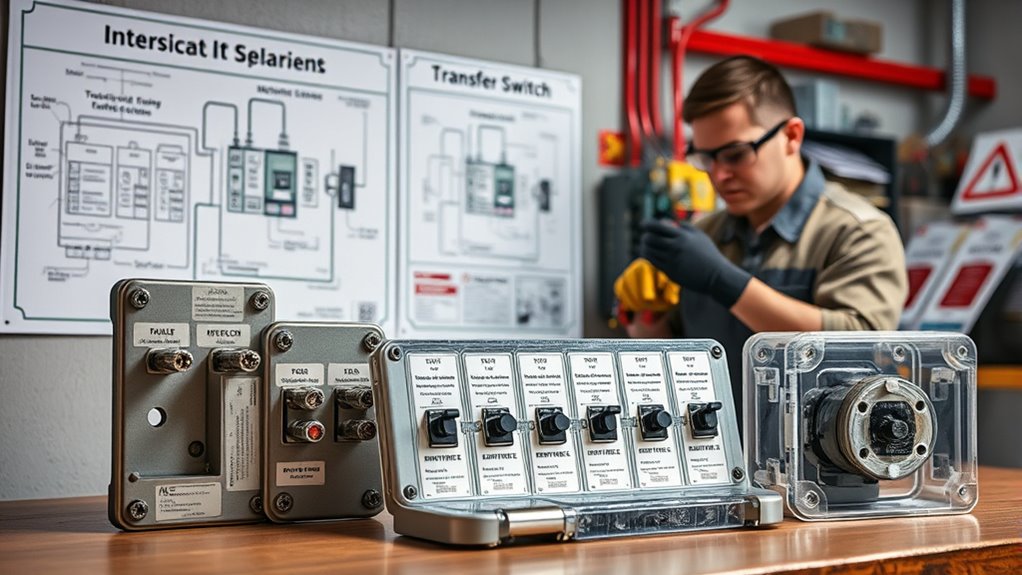
Ensuring safety and compliance with electrical codes is essential when installing and operating interlock kits and transfer switches. Proper grounding practices prevent electrical shocks and equipment damage, so make sure your system is grounded correctly. You should also check permit requirements before installation to avoid violations that could delay or invalidate your setup. Presence of mold indicates that lemon juice is no longer safe to consume. Key safety considerations include: – Verifying grounding practices align with local electrical codes – Securing all necessary permits prior to installation – Regularly inspecting for proper operation and adherence to safety standards Ignoring these steps can lead to electrical hazards or code violations, risking personal injury and legal issues. Always consult local electrical codes and professionals to guarantee your system is both safe and compliant.
Installation and Maintenance Requirements
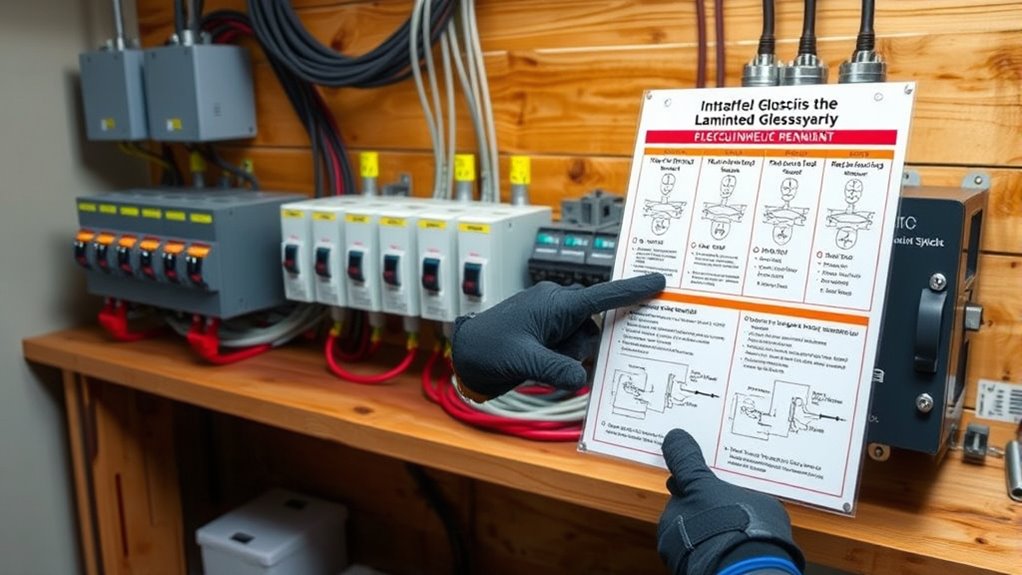
Proper installation and regular maintenance are crucial to guarantee your interlock kit or transfer switch functions safely and reliably. You should establish a clear maintenance schedule, inspecting connections, switches, and panels regularly to prevent issues. Follow manufacturer guidelines for routine checks, cleaning, and part replacements. Consistently review troubleshooting procedures so you can quickly identify and resolve common problems, such as electrical faults or faulty components. Proper installation involves ensuring all wiring complies with local codes and manufacturer instructions, which minimizes safety risks. During maintenance, look for signs of wear, corrosion, or damage, and address them promptly. Staying proactive with inspections and troubleshooting helps extend your equipment’s lifespan and ensures your backup power system is ready when needed. Additionally, understanding Cake Pops can help you appreciate the importance of precise techniques and quality tools in ensuring optimal performance and longevity of your system.
Cost and Budgeting for Backup Power Solutions
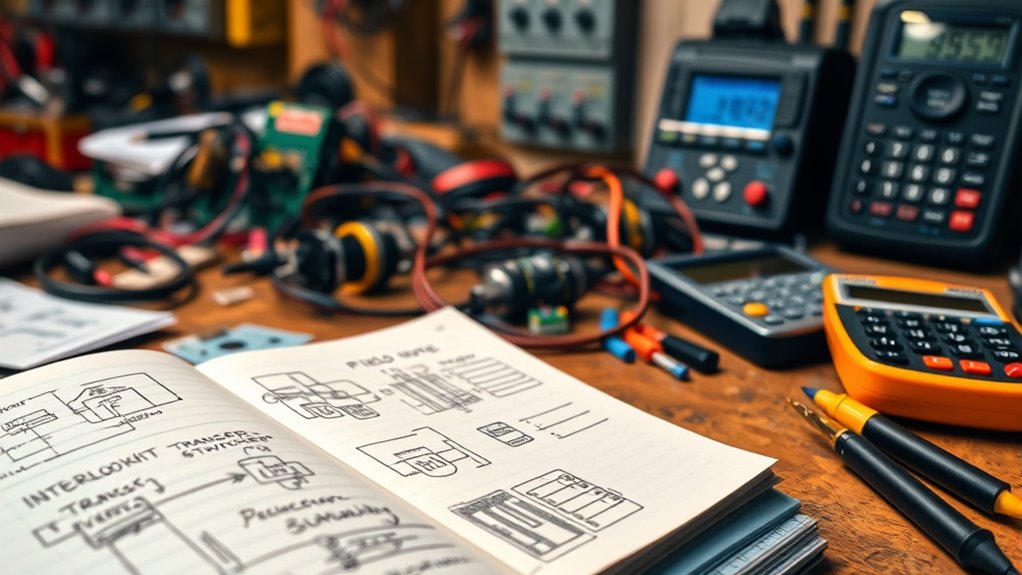
Planning your budget for backup power solutions involves understanding both the initial investment and ongoing costs. Interlock kits are typically more affordable upfront, but transfer switches may have higher installation expenses. Consider energy savings over time, as efficient systems reduce your utility bills. Warranty coverage is also crucial; a longer warranty can save you money on repairs and maintenance.
- Compare upfront costs versus long-term savings
- Factor in energy efficiency benefits
- Check warranty coverage for peace of mind
Choosing the Right Option for Your Home
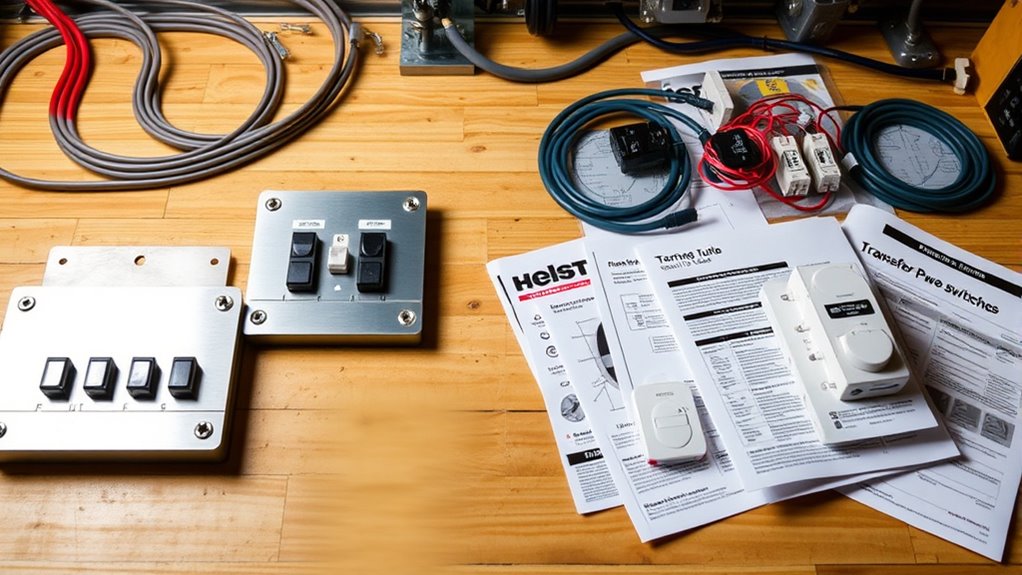
Choosing the right backup power option for your home depends on your specific needs, budget, and existing electrical setup. If you want seamless generator compatibility and weather resistance, consider your climate and the type of generator you’ll connect. An interlock kit offers easy installation and flexibility, while a transfer switch provides a more automated, weather-resistant solution. To visualize, think of this comparison:
| Feature | Interlock Kit | Transfer Switch |
|---|---|---|
| Generator Compatibility | Works with various generators | Usually specific to models |
| Weather Resistance | Less weatherproof | Designed for outdoor, weather-heavy use |
| Installation | DIY-friendly | Professional recommended |
| Cost | Lower initial cost | Higher upfront investment |
| Automation | Manual operation | Automatic switching |
Choose based on your climate, generator type, and whether you prefer simplicity or automation.
Frequently Asked Questions
Can Interlock Kits and Transfer Switches Be Installed Together?
Yes, you can install interlock kits and transfer switches together for backup power, but you must follow safety protocols. The interlock kit guarantees you don’t backfeed power into the grid, while the transfer switch safely switches your load between utility and generator. Combining both provides added safety and flexibility, especially during outages. Always consult a licensed electrician to ensure proper installation and compliance with local electrical codes.
Which Option Is More Reliable for Long-Term Use?
If you want reliability that lasts a lifetime, a transfer switch is your best bet for backup power. It’s built to handle heavy-duty use and guarantees seamless power transfer, making it incredibly dependable over time. Sure, the installation costs might be higher initially, but the peace of mind you get from a robust, long-term solution far outweighs the expense. Don’t settle for less—choose the option that truly stands the test of time.
Are There Specific Appliances Compatible With Transfer Switches?
You can typically connect essential appliances like refrigerators, sump pumps, and HVAC systems with transfer switches, but generator sizing and power management are vital. Make certain your generator can handle the combined wattage of your selected appliances. Properly managing power prevents overloads and protects your devices. Always consult your transfer switch’s compatibility list and a professional to verify your appliances’ compatibility and guarantee safe, efficient long-term operation.
How Do Local Building Codes Affect Installation Choices?
You need to follow local building codes to guarantee safe installation. Building code compliance affects your choice of transfer switches or interlock kits, as some may require specific standards. Additionally, permit requirements might apply, so check with your local authorities before starting. Ignoring these rules can lead to fines or unsafe setups. Always prioritize adhering to code guidelines and securing necessary permits to ensure a legal, safe, and efficient installation.
What Are the Environmental Impacts of Each System?
You might find that interlock kits have a lower environmental impact because they encourage using renewable energy sources, reducing your carbon footprint. Transfer switches, while efficient, often rely on fossil fuels during outages, increasing emissions. By choosing an interlock kit, you support greener solutions and decrease your overall environmental footprint, making your backup power system more sustainable and eco-friendly.
Conclusion
Choosing between interlock kits and transfer switches depends on your home’s needs and budget. Did you know that homes with properly installed backup systems experience 30% fewer damage claims during outages? By understanding how each option works and considering safety and compliance, you can make an informed decision. Investing in the right system guarantees you’re prepared, reduces risks, and keeps your family safe during emergencies. Make your choice wisely for reliable, hassle-free power when you need it most.
